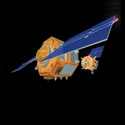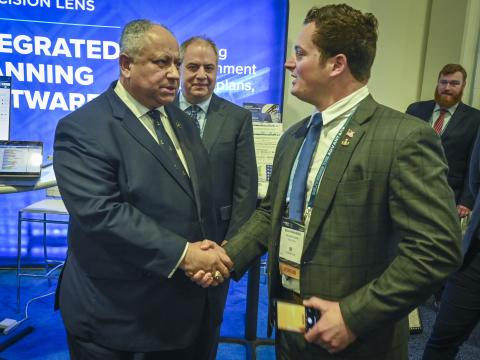Robotic Refills Extend Orbits
Nonproprietary satellite servicing interfaces portend industry-wide space infrastructure. 
The Defense Advanced Research Projects Agency (DARPA) Orbital Express mission operating in space is depicted in an artist’s concept. The Autonomous Space Transport Robotic Operations (ASTRO) servicing spacecraft (l), approaches the NextSat, a surrogate next-generation serviceable satellite. ASTRO prepares to rendezvous and dock. Boeing is the prime integrator for the program and builder of ASTRO. Ball Aerospace built NextSat.
An Orbital Express program demonstration underway almost 500 kilometers (300 miles) above the Earth is expected to have a profound effect on
Replacing outdated onboard satellite computers and other electronics moves
Electronic upgrades to satellites can provide regular performance improvements, which would dramatically reduce the time to deploy new technology on orbit, the colonel maintains. He continues that the Orbital Express demonstrator spacecraft were launched in early March from Cape Canaveral Air Force Station,
The autonomous rendezvous and capture sensor system (ARCSS) is an enabling technology being demonstrated during the mission. This capture system measures the relative angle, range, position and attitude between the two spacecraft under varying orbital environments. An onboard guidance, navigation and control (GN&C) system uses ARCSS measurement data to maneuver for autonomous rendezvous with and capture of the client spacecraft.
ARCSS tracking algorithms are designed to run interchangeably with any of the optical sensors for seamless coverage during approach. ARCSS processes all data onboard without ground system support and provides feedback to the chaser spacecraft’s GN&C system in real time.
ARCSS primary components include a continuous situational awareness infrared sensor for day and night operations. Other sensor elements include multiple visible acquisition and tracking sensors in narrow and wide fields of view along with a laser range finder and an advanced video guidance system, Col. Kennedy explains. The video system uses retro reflector targets on NextSat and a laser on ASTRO to estimate a client spacecraft’s attitude and to facilitate docking. “One of the space demonstrations also involves a soft, or low momentum, transfer docking using a special, three-finger capture mechanism, he explains.”
The Vision-based Software for Track, Attitude and Ranging, or Vis-STAR, is used to calculate independently the attitude of NextSat in addition to range and bearing. The software ensures correct alignment of NextSat during final approach and capture.
With experience as director, flight systems engineering, Space and
Funded by DARPA and the National Aeronautics and Space Administration (NASA), the prime contractor is Boeing Phantom Works, which also is contributing significant internal research and development funding to the $250 million Orbital Express program. Ball Aerospace constructed NextSat. Other team members include Northrop Grumman; MacDonald, Dettwiler and Associates Ltd.; Charles Stark Draper Laboratory; Starsys Research; and Astrotech for payload processing.
The Defense Department’s Space Test Program (STP) sponsored the Orbital Express launch. The STP-1 mission also included three other microsatellites, Col. Kennedy discloses. The Orbital Express vehicles are being controlled from the Air Force’s Research, Development, Test and
 |
| Technicians from Boeing perform post integration inspection of the DARPA Orbital Express spacecraft at Astrotech Space Operations in Titusville, Florida, prior to launch. Orbital Express, launched in March, is performing refueling and electronic unit replacement missions in orbit. |
NextSat and ASTRO were deployed together into a 492-kilometer circular orbit with an inclination of 46 degrees. The technologies developed by DARPA for Orbital Express are intended to support a broad range of future
On-orbit refueling will provide the
“Satellites in orbit today are unaware of other nearby spacecraft. Sensors such as those on Orbital Express, coupled with a refueling capability, provide awareness and open up the ability to outmaneuver antisatellite threats, while providing prospects for on-orbit assembly,” Col. Kennedy explains. Space mission designers are likely to see the advantages of the flexible architecture being demonstrated, “where you can pop in a better flight computer, a fresh battery or a decade’s worth of additional propellant,” he predicts.
During the Orbital express mission, ASTRO’s Canadian-built robotic arm will detach and reattach a flight computer from an onboard bay. A battery module also will be removed, and a new one will be inserted aboard NextSat. The arm will couple with a NextSat grappling fixture and berth the spacecraft, allowing a separate capture mechanism to perform a final docking.
Success of Orbital Express as a space-based gas station and electronics depot could open routine satellite servicing in orbit. Servicing interfaces, however, will be necessary for replenishment, which would rule out this benefit for legacy spacecraft without a capture interface or fluid coupler, Col. Kennedy points out. As now designed, Orbital Express could not grab or couple with legacy systems. Nevertheless, future space systems could be designed with common couplers and grappling points.
Another DARPA program called Front-end Robotics Enabling Near-Term Demonstration (FREND), as a follow-on to Orbital Express, could handle satellites in space with built-in servicing architecture components, Col. Kennedy declares. “FREND would approach another spacecraft, locate a likely grapping point and grab it to provide replacement modules or propellant.”
This technology is several years away. However, a FREND robotic arm development effort is underway with the Naval Research Laboratory. In the meanwhile, the colonel says, Orbital Express may be turned over to the Air Force Space Command after successfully completing scheduled demonstrations for additional activities.
The ability to replace or upgrade electronic components on deployed spacecraft would support more rapid deployment of new technologies to satellites without fielding new vehicles. Satellites could be upgraded with technologies that become available after launch, or components that fail prematurely could be replaced. Orbital Express is demonstrating precisely the technologies that could help accelerate the
Web Resources
DARPA Orbital Express: www.darpa.mil/orbitalexpress
Boeing Orbital Express: www.boeing.com/ids/advanced_systems/orbital.html
Ball Aerospace Orbital Express: www.ballaerospace.com/oexpress.html



